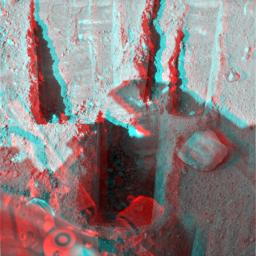
|
Deep ‘Stone Soup’ Trenching by Phoenix (Stereo)
- Click the image above for a larger view
- Full-Res JPEG (1024 x 1024) (198.0 kB)
- Full-Res TIFF (1024 x 1024) (3.1 MB)
Caption:
Digging by NASA's Phoenix Mars Lander on Aug. 23, 2008, during the 88th sol (Martian day) since landing, reached a depth about three times greater than in any trench Phoenix has excavated. The deep trench, informally called "Stone Soup" is at the borderline between two of the polygon-shaped hummocks that characterize the arctic plain where Phoenix landed.
Stone Soup is in the center foreground of this stereo view, which appears three dimensional when seen through red-blue glasses. The view combines left-eye and right-eye images taken by the lander's Surface Stereo Imager on Sol 88 after the day's digging. The trench is about 25 centimeters (10 inches) wide and about 18 centimeters (7 inches) deep.
When digging trenches near polygon centers, Phoenix has hit a layer of icy soil, as hard as concrete, about 5 centimeters or 2 inches beneath the ground surface. In the Stone Soup trench at a polygon margin, the digging has not yet hit an icy layer like that.
Stone Soup is toward the left, or west, end of the robotic arm's work area on the north side of the lander.
Background Info:
The Phoenix Mission is led by the University of Arizona, Tucson, on behalf of NASA. Project management of the mission is by NASA's Jet Propulsion Laboratory, Pasadena, Calif. Spacecraft development is by Lockheed Martin Space Systems, Denver.
Photojournal Note: As planned, the Phoenix lander, which landed May 25, 2008 23:53 UTC, ended communications in November 2008, about six months after landing, when its solar panels ceased operating in the dark Martian winter.
Cataloging Keywords:
| Name | Value | Additional Values |
|---|---|---|
| Target | Mars | |
| System | ||
| Target Type | Planet | |
| Mission | Phoenix | |
| Instrument Host | Phoenix Lander | |
| Host Type | Lander | |
| Instrument | Solid-State Imaging (SSI) | |
| Detector | ||
| Extra Keywords | Color | |
| Acquisition Date | ||
| Release Date | 2008-08-26 | |
| Date in Caption | 2008-08-23 | |
| Image Credit | NASA/JPL-Caltech/University of Arizona/Texas A&M University | |
| Source | photojournal.jpl.nasa.gov/catalog/PIA11052 | |
| Identifier | PIA11052 | |
